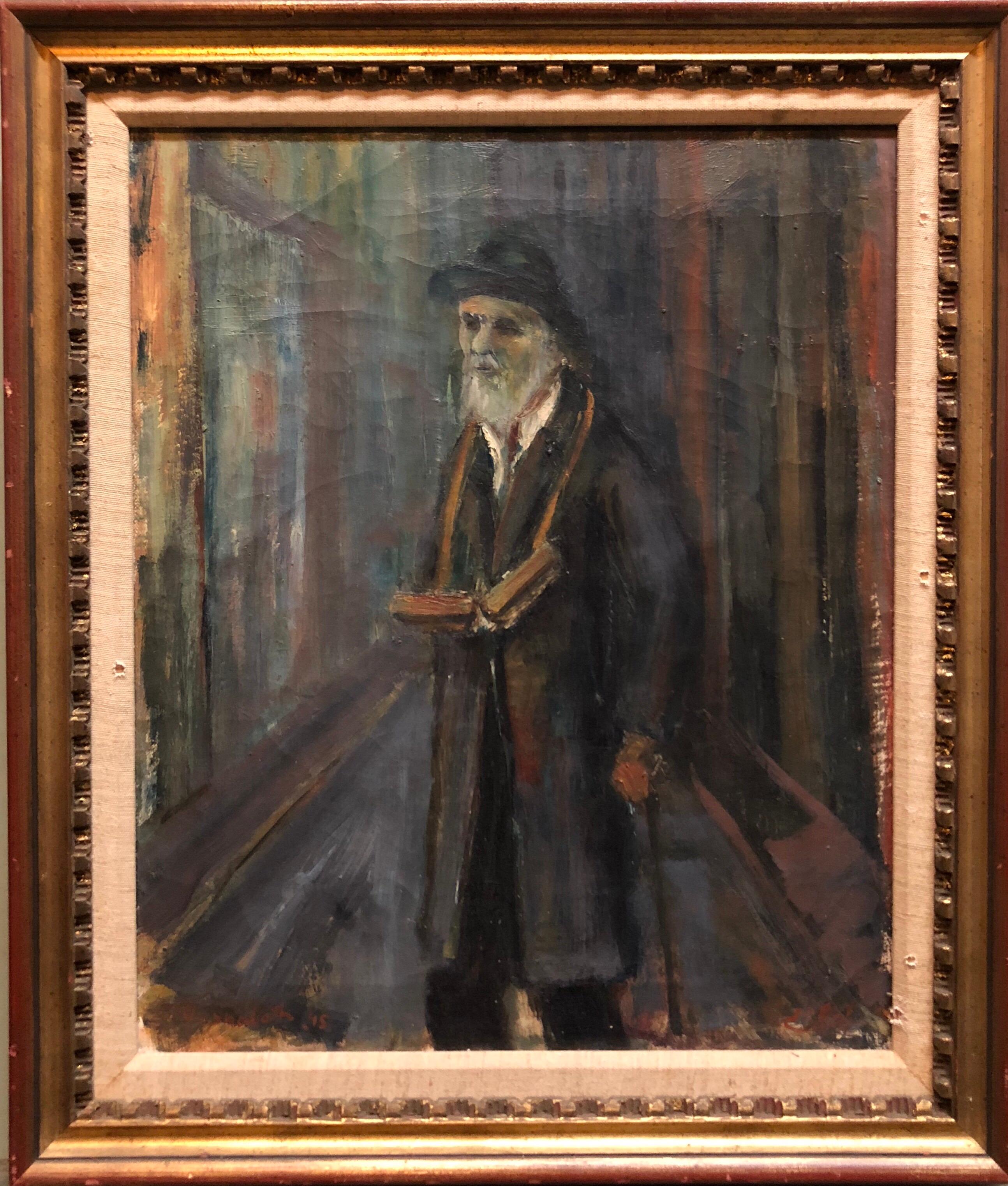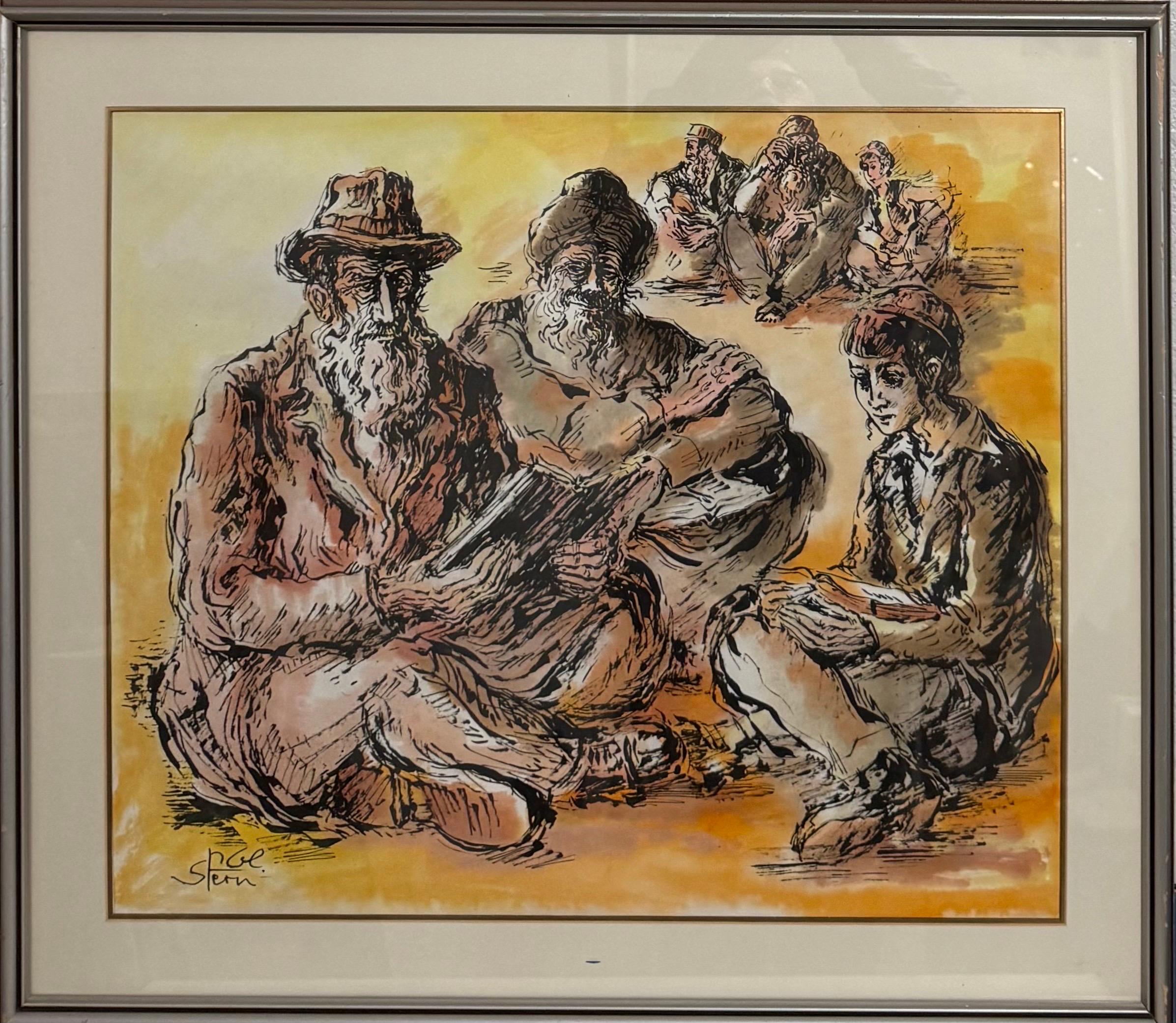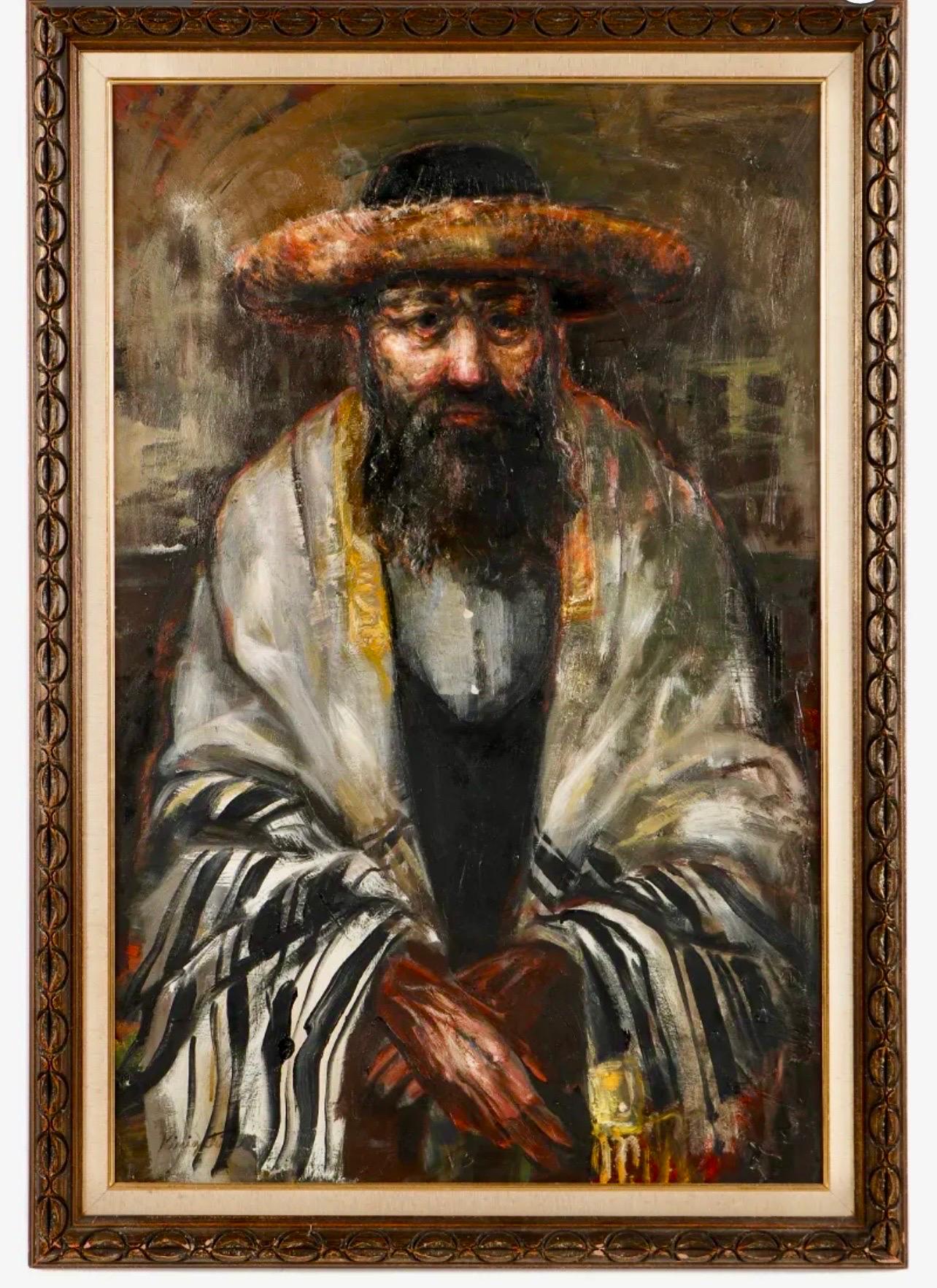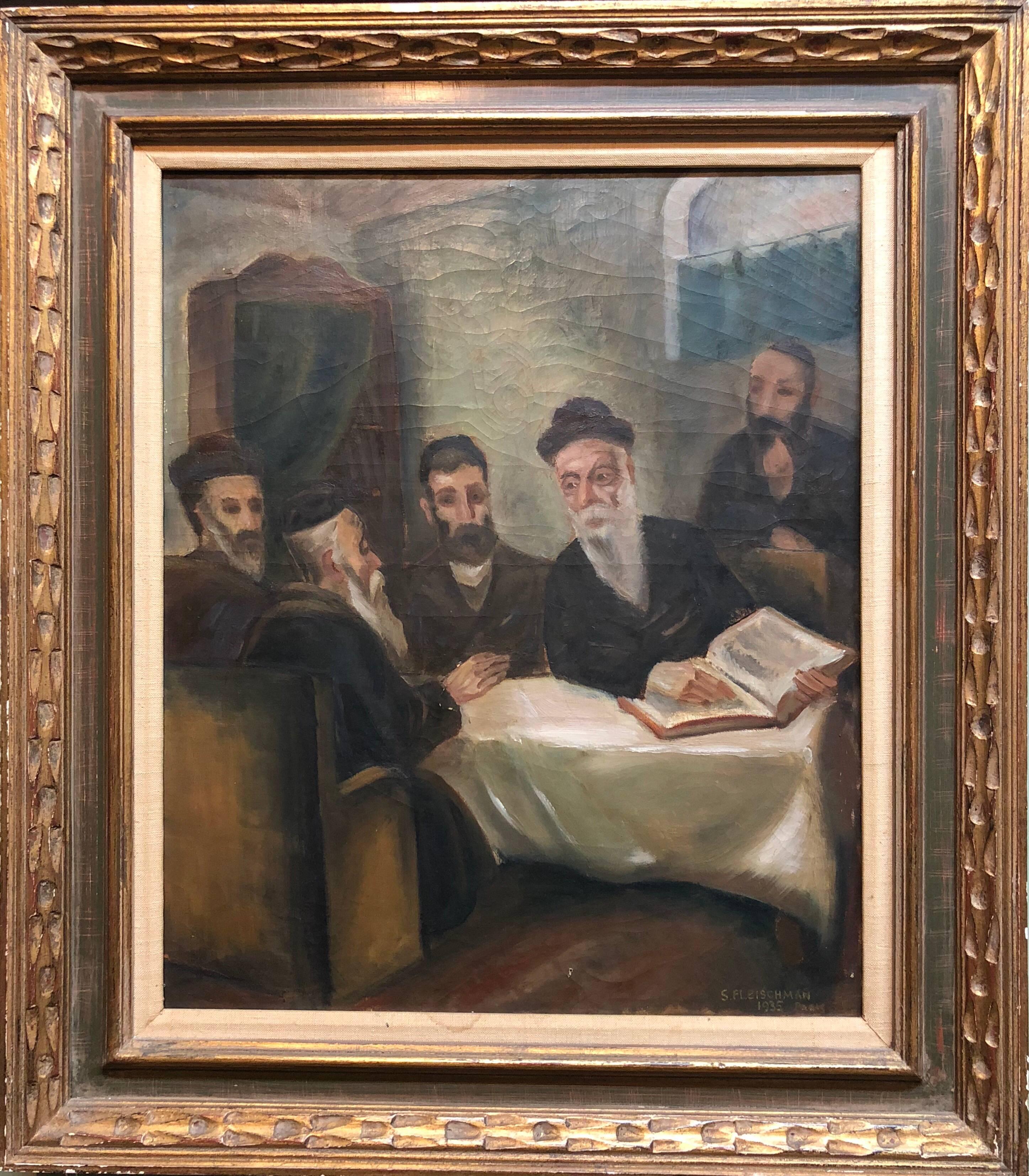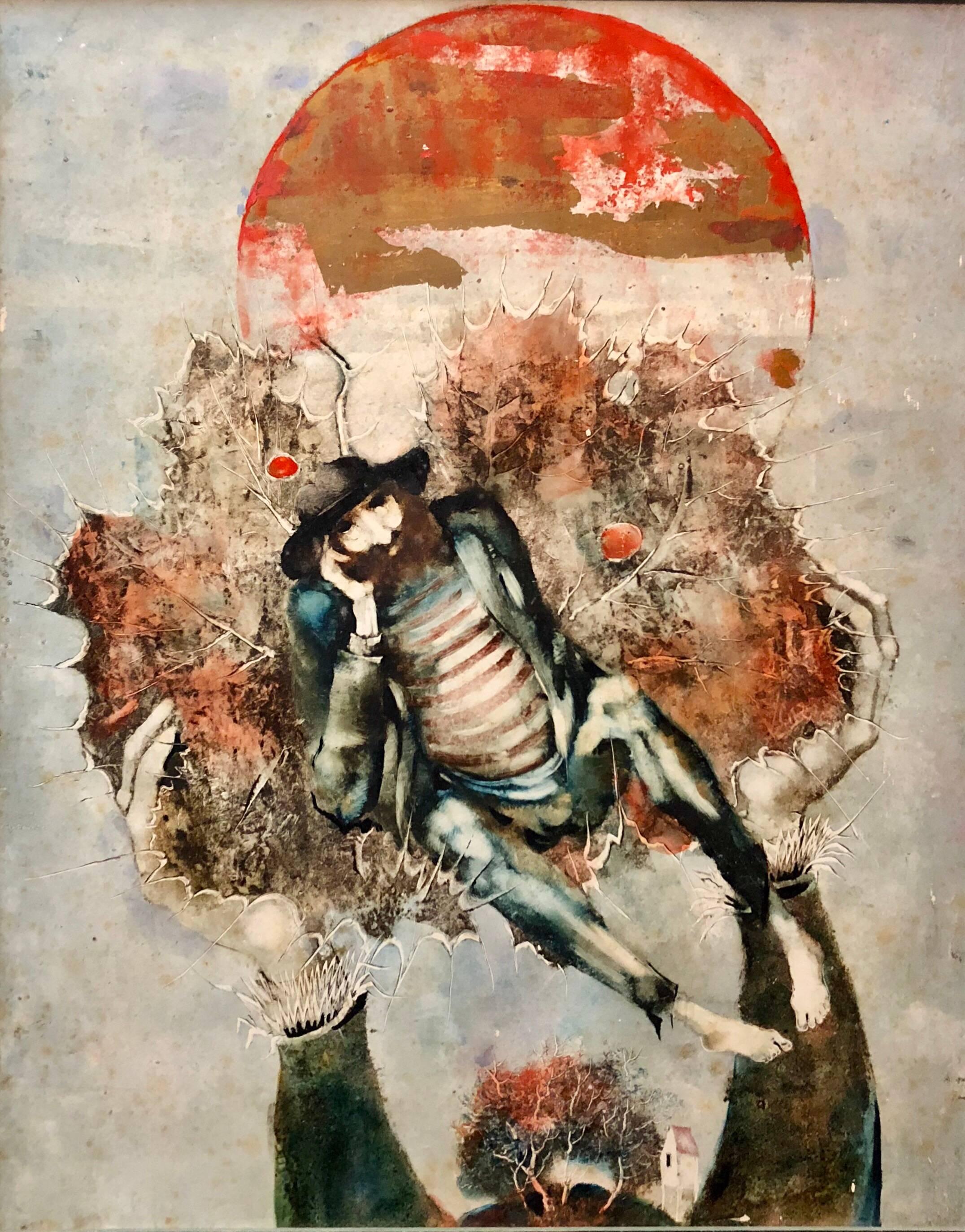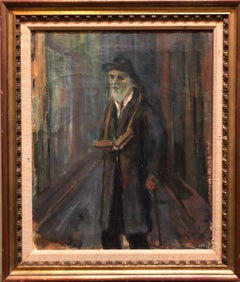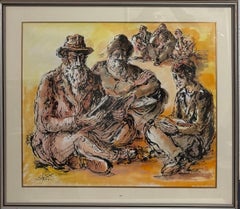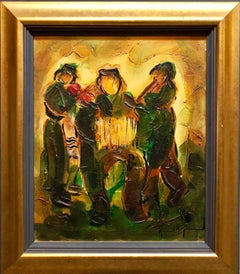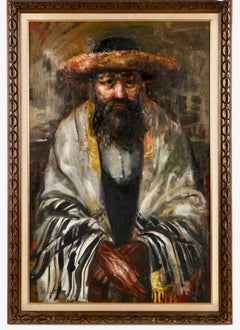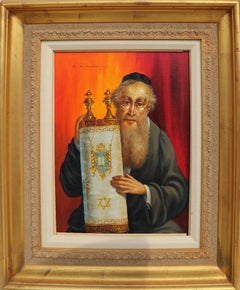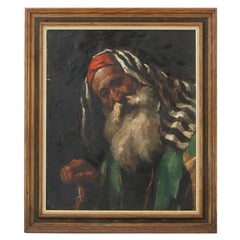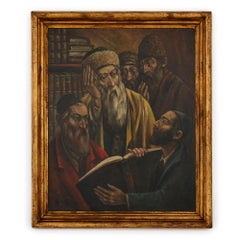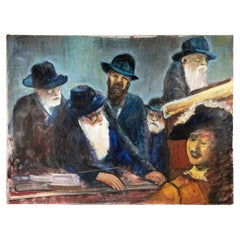Items Similar to Sephardic Jewish Men Vibrant Judaica Vintage Oil Painting Israeli Artist Goldman
Want more images or videos?
Request additional images or videos from the seller
1 of 11
Albert GoldmanSephardic Jewish Men Vibrant Judaica Vintage Oil Painting Israeli Artist Goldman
$2,500
£1,920.66
€2,206.81
CA$3,516.56
A$3,950.70
CHF 2,064.25
MX$48,220.11
NOK 26,209.89
SEK 24,671.09
DKK 16,468.06
About the Item
This depicts Middle Eastern jewish men of Sefardic descent. At least one appears to be a Rabbi.
ALBERT GOLDMAN Born in Alexandria, Egypt in 1922, Albert Goldman started drawing and painting at the age of 8. He began his art education 1936 Art with Italian and Greek artists at the "Atelier", in Alexandria, Egypt; continuing 1956 with Avraham Yaskiel and Zvi Mairovich, Haifa and with Moshe Propes, in Tel Aviv. In 1940 he obtained a diploma of commerce and opted for a career in the hospitality industry, following in the footsteps of his parents who operated the Majestic Palace Hotel in Alexandria. He moved to Cairo in 1942 to study Swiss Hotel Management at Egyptian Hotels Limited, the largest hotel company in the Middle East at the time. In 1946 he decorated an evening gown for an American singer, Catherine Essex, who sang before King Farouk. By 1947 he was the manager of the Luxor Hotel. In 1948, during an air raid over Alexandria, he was attacked by an Arab mob accusing him of signaling Israeli planes. He miraculously survived 12 stab wounds to the back. In March 1950 he married Lucette Blumenthal. He was put on the blacklist by the Ministry of Interior in Egypt, and in 1951 he managed to leave Egypt and came to Israel in September 1951 aboard the ship Artza. In 1956 he attended a drawing and painting course with Meirovich and Avraham Yaskiel in Haifa. He organized the Jerusalem Art Cellar in 1958 and settled in Jerusalem. He paints mostly Israeli landscapes, particularly of Jerusalem. This is done in a style reminiscent of Tully Filmus and Itzhak Holtz. Albert Goldman was born in 1922 in Egypt
Awards And Prizes
1983 Bnai Brith Prize, Dan region
1990 Certificate of Registration in the Golden Book of Keren Kayemet LeIsrael
Exhibition of Paintings The Municipal Museum - Bet-Emanuel, Ramat Gan
Artists: Pinchas Abramovich, Lea Avisedek, Albert Goldman, Shaul Ohaly, Robert Baser, Claire Szilard, Itamar Siani, Oded Feingersh, Ludwig Schwerin,
Sephardi Jews, also known as Sephardic Jews, Sephardim are a Jewish ethnic division originating from traditionally established communities in the Iberian Peninsula (modern Spain and Portugal). The term "Sephardim" also sometimes refers to Mizrahi Jews (Eastern Jewish communities) of Western Asia and North Africa. Largely expelled from the Iberian Peninsula in the late 15th century, they carried a distinctive Jewish diasporic identity with them to North Africa, including modern day Morocco, Algeria, Tunisia, Libya, and Egypt; South-Eastern and Southern Europe, including France, Italy, Greece, Bulgaria, and North Macedonia; Western Asia, including Turkey, Lebanon, Syria, Iraq, and Iran; as well as the Americas (although in smaller numbers compared to the Ashkenazi Jewish diaspora); and all other places of their exiled settlement. They sometimes settled near existing Jewish communities, such as the one from former Kurdistan, or were the first in new frontiers, with their furthest reach via the Silk Road.
- Creator:Albert Goldman (1922 - 2011, Egyptian, Israeli)
- Dimensions:Height: 31.5 in (80.01 cm)Width: 27.5 in (69.85 cm)
- Medium:
- Movement & Style:
- Period:
- Condition:
- Gallery Location:Surfside, FL
- Reference Number:Seller: 24621stDibs: LU38216573562
About the Seller
4.9
Platinum Seller
Premium sellers with a 4.7+ rating and 24-hour response times
Established in 1995
1stDibs seller since 2014
1,788 sales on 1stDibs
Typical response time: <1 hour
- ShippingRetrieving quote...Shipping from: Surfside, FL
- Return Policy
Authenticity Guarantee
In the unlikely event there’s an issue with an item’s authenticity, contact us within 1 year for a full refund. DetailsMoney-Back Guarantee
If your item is not as described, is damaged in transit, or does not arrive, contact us within 7 days for a full refund. Details24-Hour Cancellation
You have a 24-hour grace period in which to reconsider your purchase, with no questions asked.Vetted Professional Sellers
Our world-class sellers must adhere to strict standards for service and quality, maintaining the integrity of our listings.Price-Match Guarantee
If you find that a seller listed the same item for a lower price elsewhere, we’ll match it.Trusted Global Delivery
Our best-in-class carrier network provides specialized shipping options worldwide, including custom delivery.More From This Seller
View AllJudaica Oil Painting 1945 Palestine Old Jewish Man Polish Israeli Artist
By Ozer Shabat
Located in Surfside, FL
Ozer Shabat 1978-1901
Ozer Shabbat was an Israeli painter, a resident of Haifa. Belonged to the Palestine Expressionist group of the late 1920s and early 1930s.
Shabbat was born in Wolbrom, Poland. At the end of the First World War he went to Holland for agricultural training in the framework of the HeChalutz movement, prior to his immigration to Palestine. In 1920 he immigrated to Eretz Israel and joined the Hulda group. Later he joined the Merhavia group and there he began painting. Because of his desire to study drawing, he left the group and moved to Jerusalem. In 1921, he wrote articles in the newspaper "HaSadeh" on the subject of agriculture and Dutch cheese.
Ozer Shabath won the first prize in a competition for the design of the Dutch Consulate's Garden in Jerusalem, enabling him to travel to Paris in 1923 to study painting. Until 1925 he studied painting at the Grande Chaumiere Academy in Paris. This year he returned to Eretz Israel and settled in Haifa, where he lived until his death.
In 1928 he participated for the first time in an exhibition of Eretz Israel artists at the Tower of David. Since then he has participated in all the general exhibitions of Israeli artists. In 1934, together with painters Menachem Shemi, Avraham Mohar, Zvi Meirovitch and others, he founded the Haifa Artists' Group. In 1935-36 he toured Europe and visited Italy, France and England. During his visit, he maintained contacts with artists from the Jewish school of Paris.
He has exhibited in several solo exhibitions, represented Israel in exhibitions in Europe and participated in international exhibitions in New York, Johannesburg and Zurich. In 1958 he represented Israel in the Venice Biennale. In 1960, Shabat, together with Elchanan Halpern he represented the Israeli Painters Association at the International Congress of Plastic Arts held in Vienna, Austria . In the 40s and 50s he focused on landscape pictures. However, despite the focus on the Israeli landscape, the approach is universal in the framework of the post-Impressionist painting school. In the 1960s, his approach changed and he turned more to abstraction. The abstract direction gradually evolved. The point of departure of the abstract approach is the architectural landscape, but this view loses its real character and becomes only imaginary: the buildings lose their real character and turn into exclusive geometric areas that are usually set against a dark background. Over time, architecture captured the lion's share of his paintings. Cities like Safed, Jaffa and Jerusalem are the subject of many pictures.
He taught painting and art at the schools of the kibbutzim in Ramat Yochanan and Kfar Yehoshua, in high schools in Haifa and in the IDF and Gordon seminars.
His paintings were purchased and are in the permanent collection of the Bezalel National Museum (now the Israel Museum), Haifa Museum of Art, Haifa Maritime Museum, Acre Municipal Museum.
Select Solo exhibitions
1936 - Nadler Gallery, Haifa.
1943 - The Tel Aviv Museum of Art.
1952 - Artists House, Haifa.
1953 - Bezalel House, Jerusalem.
1955 - Gallery in Geneva, Switzerland.
1955 - The Writers' Club, Haifa.
1959 - Artists House, Haifa.
1960 - Museum of Modern Art, Haifa.
1962 - Museum of Modern Art, Haifa.
1963 - Gallery 220, Tel Aviv.
1968 - The Municipal Museum of Beit Emanuel, Ramat Gan.
1979 - Memorial exhibition marking the first anniversary...
Category
1940s Post-Impressionist Figurative Paintings
Materials
Canvas, Oil
Old City Jerusalem City Walls landscape Scene Painting, Judaica
By Jossi Stern
Located in Surfside, FL
Vibrant Gouache and watercolor painting by Israeli master JOSSI STERN. on paper mounted to board.
Dimensions: 29.5 X 33.5 23 X 27
Jossi (Yossi) Stern, (Hungarian Israeli 1923 - ...
Category
20th Century Modern Figurative Paintings
Materials
Watercolor, Gouache, Illustration Board
Jewish Klezmer Musicians, Israeli Judaica Impasto Palette Knife Oil Painting
By Raoul Raymond
Located in Surfside, FL
Raoul Raymond was born in Bucharest, Romania in 1948 and he immigrated to Israel two years later.
In Israel, Mr. Raymond grew fond of the artist's palette, and at an early age, was...
Category
20th Century Figurative Paintings
Materials
Oil
Large Judaica Oil Painting Rabbi Rediscovered NY Artist Simchat Torah
By Jonah Kinigstein
Located in Surfside, FL
"Simchat Torah" by Jonah Kinigstein
Large Oil on Board Painting of Rabbi
Frame: 46 X 32
Image: 39 X 25.5
Jonah Kinigstein (b. 1923) is an American Postwar & Contemporary painter. H...
Category
20th Century Expressionist Portrait Paintings
Materials
Oil, Board
Rare French, Paris 1935 Judaica Oil Painting Rabbis Studying S. Fleischman
Located in Surfside, FL
Rare Judaica Art. Jewish genre scene. In the tradition of Moritz Oppenheim, Isidor Kauffman and Maurycy Gottlieb and later of Tully Filmus, Zalman Kleinman and Itshak Holtz the artist captures this Jewish scene with a particular sensitivity. Part of the Ecole De Paris The term "School of Paris" was used in 1925 by André Warnod (fr) to refer to the many foreign-born artists who had migrated to Paris.
School of Paris artists were progressively marginalized. Beginning in 1935 art publications no longer wrote about Marc Chagall, just magazines for Jewish audiences, and by June 1940 when the Vichy government took power, School of Paris artists could no longer exhibit in Paris at all.
The artists working in Paris between World War I and World War II experimented with various styles including Cubism, Orphism, Surrealism and Dada. Foreign and French artists working in Paris included Jean Arp, Joan Miró, Constantin Brâncuși, Raoul Dufy, Tsuguharu Foujita, artists from Belarus like Michel Kikoine, Pinchus Kremegne, and Jacques Lipchitz, the Polish artist Marek Szwarc and others such as Russian-born prince Alexis Arapoff. A significant subset, the Jewish artists, came to be known as the Jewish School of Paris or the School of Montparnasse. The "core members were almost all Jews, and the resentment expressed toward them by French critics in the 1930s was unquestionably fueled by anti-Semitism." One account points to the 1924 Salon des Indépendants, which decided to separate the works of French-born artists from those by immigrants; in response critic Roger Allard (fr) referred to them as the School of Paris. Jewish members of the group included Emmanuel Mané-Katz, Chaim Soutine, Adolphe Féder, Chagall, Moïse Kisling, Maxa Nordau...
Category
Mid-20th Century Post-Impressionist Figurative Paintings
Materials
Oil, Board
Mid Century Hungarian Gilt Oil Painting on Board Modern Judaica
Located in Surfside, FL
From a collection by a long time Miami Beach art dealer on the old Lincoln Rd. This is a piece he brought back from hungary. from a collection of good Hungarian artists and Illustrat...
Category
20th Century Modern Figurative Paintings
Materials
Oil, Board
You May Also Like
Rabbi and Torah, Oil Painting by Abraham Straski
By Abraham Straski
Located in Long Island City, NY
Artist: Abraham Straski, Polish (1903 - 1987)
Title: Rabbi and Torah
Year: circa 1957
Medium: Oil on Canvas, signed l.r.
Image Size: 16 x 12 inches
Frame Size: 26 x 20 inches
Category
1950s Post-War Portrait Paintings
Materials
Canvas, Oil
Judaica Hungarian Oil Painting of a Rabbi By Miklos Mihalovits
Located in Long Island City, NY
Miklos Mihalovits, Hungarian, 1888 to 1960, an oil painting on canvas, Portrait of an old Rabbi. Signed lower left. Framed. Miklos Mihalovits is known for Figure, genre paintings. Miklos Mihalovits was a Hungarian painter born in 1888. Miklos pursued his studies at the High School of Applied Arts and the Benczur Master School, in Budapest. He also took in study tours in Italy and Germany. Miklos Mihalovits art is characterized by bright colours and temperamental shaping, which can be seen in his paintings of study heads for biblical compositions and nude figures. His work was exhibited from 1912 on. Miklos also participated in collective exhibitions in Budapest from 1929 through 1930. He was one of the founders of the National Saloon. European Fine Art...
Category
Antique 19th Century Unknown Paintings
Materials
Paint
Polish Oil Painting of Jewish Men Studying by Arthur Bryks
By Arthur Bryks
Located in London, GB
Polish oil painting of Jewish men studying by Arthur Bryks
Polish, c. 1925-30
Frame: Height 108cm, width 89.5cm, depth 5cm
Canvas: Height 93cm, width 74.5cm
Painted by the Polish ar...
Category
Early 20th Century Portrait Paintings
Materials
Canvas, Oil
Large Scale Oil On Canvas, Group Of Rabbis
Located in Bridgeport, CT
Five bearded rabbis wearing hats are seated at a table with books. They are visited by a woman in yellow and wearing a hat. Apparently unsigned.
Dimensions: 48 x 64", Depth 2"
Con...
Category
20th Century Mid-Century Modern Paintings
Materials
Canvas
Rabbi, 1970s Oil Painting by Donald Roy Purdy
By Donald Roy Purdy
Located in Long Island City, NY
Artist: Donald Roy Purdy, American (1924 - )
Title: Rabbi with Torah
Year: circa 1970
Medium: Oil on Masonite, signed l.r.
Size: 30 x 22.5 in. (76.2 x 57.15 cm)
Frame Size: 38 x 31 i...
Category
1970s Modern Figurative Paintings
Materials
Masonite, Oil
Rabbis Studying the Thorah
By Jacob Steinhardt
Located in San Francisco, CA
Artist: Jakob Steinhardt (German/Israeli, 1887-1968)
Title: Rabbis Studying the Thorah
Year: Circa 1960
Medium: Color woodcut
Paper: Wove
Image size...
Category
Mid-20th Century Expressionist Figurative Prints
Materials
Woodcut
Price Upon Request
More Ways To Browse
Vintage Greek Art
Eastern European Artists
Mens Vintage French
Painting By Numbers Vintage
Judaica Artist
Jew Painting
Modern Judaica Painting
Vintage Bulgaria
Spanish Jewish
Vintage Western Painting
Jewish Rabbi Painting
Rabbi Studying
Egyptian Silk
15th Century Italian Painting
Rabbi Drawing
Arab Drawing
Vintage Western Oil Paintings
Vintage Tunisian
